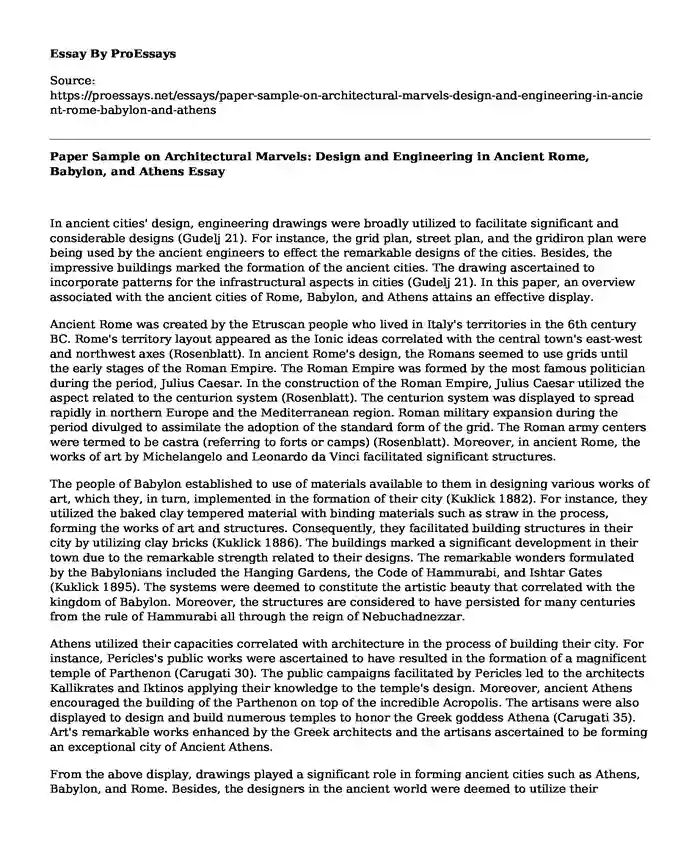In ancient cities' design, engineering drawings were broadly utilized to facilitate significant and considerable designs (Gudelj 21). For instance, the grid plan, street plan, and the gridiron plan were being used by the ancient engineers to effect the remarkable designs of the cities. Besides, the impressive buildings marked the formation of the ancient cities. The drawing ascertained to incorporate patterns for the infrastructural aspects in cities (Gudelj 21). In this paper, an overview associated with the ancient cities of Rome, Babylon, and Athens attains an effective display.
Ancient Rome was created by the Etruscan people who lived in Italy's territories in the 6th century BC. Rome's territory layout appeared as the Ionic ideas correlated with the central town's east-west and northwest axes (Rosenblatt). In ancient Rome's design, the Romans seemed to use grids until the early stages of the Roman Empire. The Roman Empire was formed by the most famous politician during the period, Julius Caesar. In the construction of the Roman Empire, Julius Caesar utilized the aspect related to the centurion system (Rosenblatt). The centurion system was displayed to spread rapidly in northern Europe and the Mediterranean region. Roman military expansion during the period divulged to assimilate the adoption of the standard form of the grid. The Roman army centers were termed to be castra (referring to forts or camps) (Rosenblatt). Moreover, in ancient Rome, the works of art by Michelangelo and Leonardo da Vinci facilitated significant structures.
The people of Babylon established to use of materials available to them in designing various works of art, which they, in turn, implemented in the formation of their city (Kuklick 1882). For instance, they utilized the baked clay tempered material with binding materials such as straw in the process, forming the works of art and structures. Consequently, they facilitated building structures in their city by utilizing clay bricks (Kuklick 1886). The buildings marked a significant development in their town due to the remarkable strength related to their designs. The remarkable wonders formulated by the Babylonians included the Hanging Gardens, the Code of Hammurabi, and Ishtar Gates (Kuklick 1895). The systems were deemed to constitute the artistic beauty that correlated with the kingdom of Babylon. Moreover, the structures are considered to have persisted for many centuries from the rule of Hammurabi all through the reign of Nebuchadnezzar.
Athens utilized their capacities correlated with architecture in the process of building their city. For instance, Pericles's public works were ascertained to have resulted in the formation of a magnificent temple of Parthenon (Carugati 30). The public campaigns facilitated by Pericles led to the architects Kallikrates and Iktinos applying their knowledge to the temple's design. Moreover, ancient Athens encouraged the building of the Parthenon on top of the incredible Acropolis. The artisans were also displayed to design and build numerous temples to honor the Greek goddess Athena (Carugati 35). Art's remarkable works enhanced by the Greek architects and the artisans ascertained to be forming an exceptional city of Ancient Athens.
From the above display, drawings played a significant role in forming ancient cities such as Athens, Babylon, and Rome. Besides, the designers in the ancient world were deemed to utilize their stunning skills in providing works of art that, in turn, enhanced the process of forming cities. Accordingly, the output observed from the city structures portrayed significant levels of hard work from ancient engineers.
Works Cited
Carugati, Federica, Josiah Ober, and Barry R. Weingast. "Is development uniquely modern? Ancient Athens on the doorstep." Public Choice 181.1-2 (2019): 29-47. https://link.springer.com/article/10.1007/s11127-018-00632-w
Gudelj, Jasenka. "The Early Modern Tale (s) of Two Ancient Cities." A Handbook to Classical Reception in Eastern and Central Europe (2017): 21. https://onlinelibrary.wiley.com/doi/abs/10.1002/9781118832813#page=39
Kuklick, Bruce. Puritans in Babylon: the ancient Near East and American intellectual life, 1880-1930. Princeton University Press, 2018. https://books.google.co.ke/books?hl=en&lr=&id=anh1DwAAQBAJ&oi=fnd&pg=PP1&dq
Rosenblatt, Helena. The lost history of liberalism: from ancient Rome to the twenty-first century. Princeton University Press, 2020. https://books.google.co.ke/books?hl=en&lr=&id=Ib2tDwAAQBAJ&oi=fnd&pg=PR1&dq
Cite this page
Paper Sample on Architectural Marvels: Design and Engineering in Ancient Rome, Babylon, and Athens. (2023, Dec 17). Retrieved from https://proessays.net/essays/paper-sample-on-architectural-marvels-design-and-engineering-in-ancient-rome-babylon-and-athens
If you are the original author of this essay and no longer wish to have it published on the ProEssays website, please click below to request its removal:
- BMW Are the Best Cars
- Funeral Oration of Pericles in the Ancient History Sourcebook
- Iconography, Symbolism, and Functions of Stained Glass Windows of Gothic Cathedrals
- The Road From Slavery to Success Essay
- Mendeleev's Discoveries in Chemistry and Its Influence Paper Example
- Essay Sample on The Wrath of Achilles and its Role in the Iliad
- Article Analysis Essay on Understanding a Photograph







